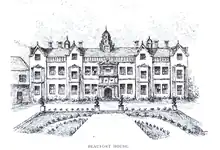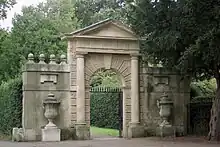51°28′59″N 0°10′30″W / 51.483°N 0.175°W

Beaufort House was a grand mansion built beside the River Thames at Chelsea, London, by Thomas More in about 1520, while he held the position of Lord High Chancellor to King Henry VIII. On his arrest in 1534 all of More's property was forfeit to the Crown. The house was given the name of Beaufort House only in 1682, when it passed into the hands of the 1st Duke of Beaufort. It was demolished in 1740, giving its name to present-day Beaufort Street.
History
As More's royal duties frequently required his attendance at the king's Thames-side palaces in both Richmond and Greenwich, it was convenient to select a riverside property situated between them (the common method of transport being by boat) for his home. In about 1520, for £30 (equivalent to £20,000 in 2021) he purchased a 27-acre (11-hectare) parcel of land stretching from the Thames in Chelsea to the present-day King's Road; the east and west boundaries are represented by the present-day Old Church Street and Millman's Street.[1] There he built a dignified red-brick mansion (known simply as More's house or Chelsea House). As well as a family chapel within the building, More had built a separate, small chapel in the grounds for himself for solitary prayer and penance.[2]
More moved in by 1525, as is shown by the bawdy poem The Twelve Mery Jestes of Wyddow Edyth, written by a member of More's household (or even by More himself) using the pseudonym of "Walter Smith" and published in March of that year: the widow arrives by boat at "Chelsay[…]where she had best cheare of all/in the house of Syr Thomas More."[3][4]

Upon More's arrest in 1534 the estate was confiscated, coming into the possession of the Comptroller of the Royal Household, William Paulet. In 1538 it was considered sufficiently impressive to give as temporary accommodation to Louis de Perreau, Sieur de Castillon, the French ambassador to the English court; the delicate matter of choosing a French royal wife for King Henry (after the death of Queen Jane Seymour) was under consideration.[5][6] Subsequent owners associated with the royal household included Paulet's son, John Paulet, 2nd Marquess of Winchester, and Gregory Fiennes, Lord Dacre of the South. After the execution of Fiennes the house passed to Lord Burleigh, Queen Elizabeth's chief minister, to be followed by his youngest son, Sir Robert Cecil, afterwards Earl of Salisbury, who took possession in 1597.[7] Cecil remodelled the front of the house in 1597, using the designs of architect John Thorpe, but shortly afterwards he sold it to Henry Clinton, 2nd Earl of Lincoln in order to buy property nearer to Westminster.[8]

By 1620 the property had passed through the hands of the Earl of Lincoln into the possession of the earl's son-in-law Sir Arthur Gorges, who sold it to Lionel Cranfield, 1st Earl of Middlesex. In 1627, Cranfield surrendered the estate to the Duke of Buckingham, when it became known as Buckingham House. In 1674, it was acquired by the Earl of Bristol, whose widow Anne sold it to the Marquess of Worcester, the future Duke of Beaufort. In 1682 the property was renamed Beaufort House after its new owner.[9] It gave its name to the present-day Beaufort Street.[7]
The final owner, from 1737, was Sir Hans Sloane, who demolished the building in 1739.[7] The north (Kings Road) gate to the property, designed by Inigo Jones, was saved and transported to Chiswick House.[10]
References
- ↑ Wood, Martin (2008). The Family and Descendants of St. Thomas More. Leominster, England: Gracewing. p. 54. ISBN 9780852446812.
- ↑ Ackroyd, Peter (1998). The life of Thomas More. London: Chatto & Windus. p. 235. ISBN 1-85619-711-5.
- ↑ Ackroyd (1998) p. 244.
- ↑ Bibliographer William Carew Hazlitt in his Shakespeare Jest Book Volume III (OCLC 690506548) assigns publication of the work to More's brother-in-law John Rastell, with a date of 23 March 1525.
- ↑ Ackroyd (1998) p. 248
- ↑ MacCulloch, Diarmaid (2018). Thomas Cromwell : a life. London: Penguin Books. p. 449. ISBN 978-1-84614-429-5.
- 1 2 3 Godfrey, Walter H. "Survey of London: The site of Beaufort House | British History Online". www.british-history.ac.uk. London County Council. Retrieved 25 November 2022.
- ↑ Stone, Lawrence (1961). "The Fruits of Office". In Fisher, F. J. (ed.). Essays in the Economic and Social History of Tudor and Stuart England. Cambridge University press. p. 105. ISBN 978-0-521-02552-2.
- ↑ Beaver, Alfred (1892). Memorials of Old Chelsea. London: Elliot Stock. pp. 118–138. OCLC 499072940.
In…1682…Chelsey…was sold to…the first Duke of Beaufort…and henceforth bore [the] name.
- ↑ "Inigo Jones's Gateway in Chiswick Park". Historic England.